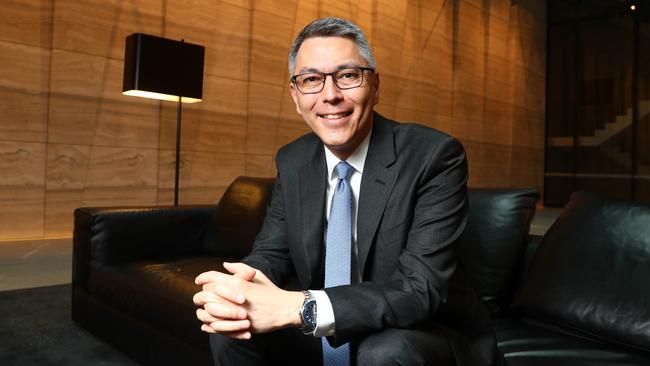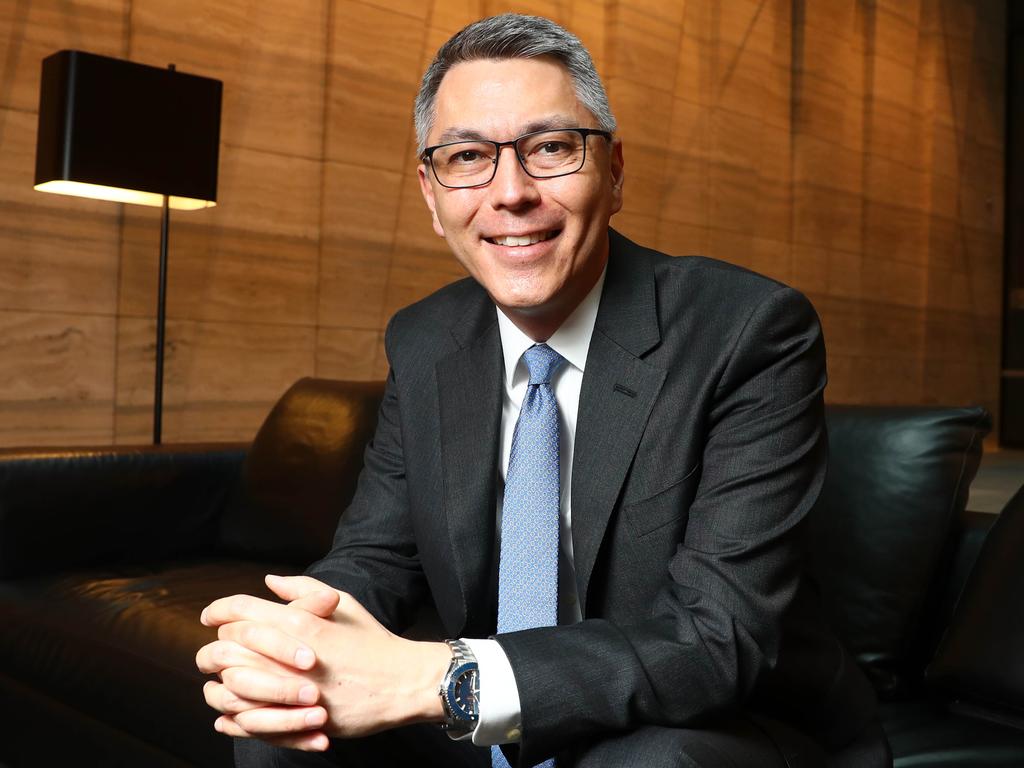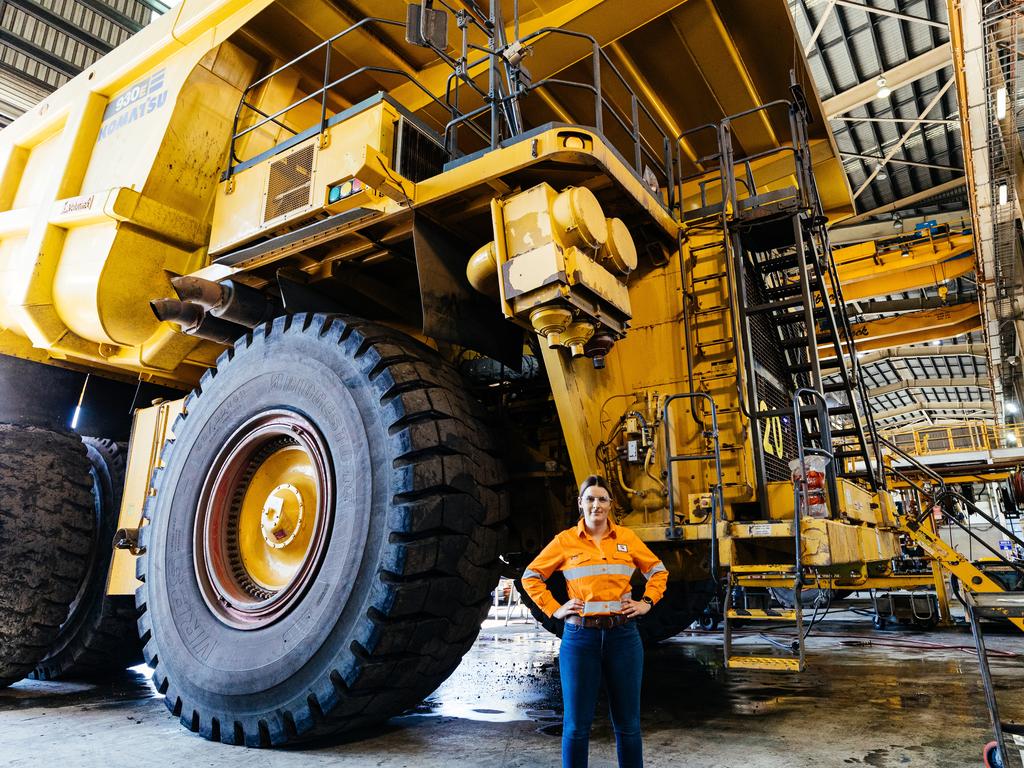BHP executives face carbon test
BHP to put 10pc of its bosses’ bonus payments on the line over a plan to cut carbon emissions by 30pc by 2030.

BHP boss Mike Henry will put 10 per cent of his leadership team’s bonus payments on the line over the mining giant’s plan to reduce its carbon emissions by 30 per cent by 2030, as the company outlines its approach to dealing with its contribution to climate change over the next decade.
Speaking to investors on Thursday evening, Mr Henry unveiled BHP’s carbon emission targets for the coming decade, committing the company to “pursue efforts” to limit global warming to 1.5 degrees celsius above pre-industrial levels.
Mr Henry told analysts the company would seek to slash scope one and two carbon emissions – those directly attributable to its own emissions, and third party providers that power its sites – by 30 per cent from 2020 levels within a decade.
The BHP boss also outlined the bones of BHP’s plans to work with its customers to reduce emissions coming from the use of its products, setting a target of helping its steel mill customers to “to identify pathways and develop technologies by 2030 to reduce emissions intensity by 30 per cent”.
“We will adjust our baseline for acquisitions and divestments – there will be no ‘free pass’ from any material divestments of higher-carbon operations,” Mr Henry said.
“We are also making a direct connection between these measures and executive remuneration, with 10 per cent of the short-term incentive part of my remuneration, and those of our leaders, contingent on meeting targets and goals associated with these commitments. Every year.”
BHP says its operations directly produced 9.5 million tonnes of carbon dioxide equivalent last financial year, with scope 2 emissions worth another 6.3 million tonnes.
It estimates that emissions attributable to the use of its products were worth another 563 million tonnes.
BHP’s new targets are a substantial shift from its former plan – to maintain total operational emissions (including scope 1 and 2) at or below 2017 financial year levels through to the middle of 2022. They are also ahead of Rio Tinto’s ambition of reducing its absolute carbon emissions by 15 per cent by 2030.
But they still disappointed climate activist groups, which say BHP would need to cut total emissions by 21 per cent by 2025 and 42 per cent by 2030 to pull its weight and keep global warming on track to sit below 1.5 degrees.
Dan Gocher, Director of Climate & Environment at the Australasian Centre for Corporate Responsibility (ACCR) said the company’s goals fail to deliver “any meaningful outcomes in terms of actual emissions reduction”.
“It needs to try harder. BHP should be aiming for a 40-60 per cent reduction in all of its emissions by 2030,” he said.
“While BHP claims that its medium-term target ‘falls within the range of emissions reductions required to be aligned with the goals of the Paris Agreement’, most climate scientists would disagree. BHP is also cynically using the 2020 financial year as a baseline, rather than a historical, lower number.”
And Mr Henry’s resolute decision to stick by his guns and continue to invest in oil and gas will also win him no favours with environmentalists, with the BHP boss telling investors he still believed the sector offered attractive returns for the company.
“While the shift to cleaner energy sources is clear, the world will still need oil and gas to power mobility and everyday modern life on the pathway to decarbonisation,” he said.
Mr Gocher said BHP’s decision to stick by the sector undermined its broader strategy.
“BHP may have finally given up on thermal coal but it and its industry associations are still betting heavily on gas – which is proven to have the same, if not worse emissions than coal once fugitive methane emissions are factored in,” he said.
But other climate change-focused investor groups were more positive on the announcement, with Investor Group on Climate Change chief executive Emma Herd saying she was pleased with the progress shown in BHP’s new targets.
“Importantly, BHP’s analysis shows that large diversified miners can generate significant shareholder value under rapid decarbonisation pathways that are consistent with the Paris Agreement goals,” she said.
“We also note the significant work BHP has put into understanding its scope 3 emissions, the new medium-term targets across all emissions scopes and the link to executive remuneration. Investors want climate risk analysis to inform core business decisions and look forward to continuing to engage with BHP to ensure continued momentum on this front.”
While BHP is well on the way to decarbonising power supply to its plants, recently announcing new renewable energy contracts for its Queensland coal mines which will halve emissions by 2025, senior executives admitted other parts of its operations will be tougher to fix.
To achieve its goal of releasing no net carbon emissions by 2050, BHP will also need to reduce the reliance of its remote sites on diesel-powered trucks. And although that is a high priority target for BHP, given burning diesel released 6.3 million tonnes of carbon emissions last financial year or 40 per cent of BHP’s operational total.
But electrifying its truck fleet will be a far more difficult task than replacing power contracts, according to BHP vice president of sustainability and climate change Fiona Wild.
“This is a more complex task, as displacing diesel requires partnership with others to test and develop new technologies, with significant lead times for implementation,” she said.
”The path to electrification of mining equipment will include solutions such as trolley assist, overland conveyors and battery solutions. Taking a scalable approach provides flexibility for the rapid development of emerging technologies and resolves the complexities of integrating these into existing operations.”
BHP shares closed up 20c to $36.98 on Thursday.




To join the conversation, please log in. Don't have an account? Register
Join the conversation, you are commenting as Logout